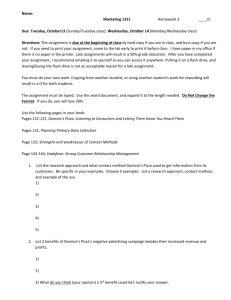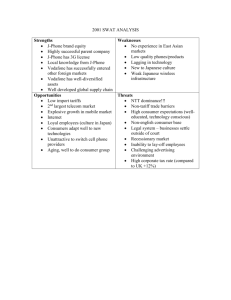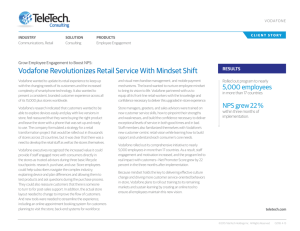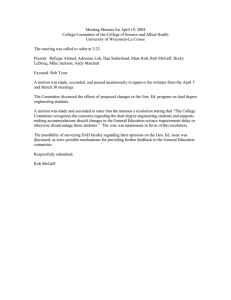From mobility to ubiquity: ITU Workshop on Ubiquitous Network April 2005
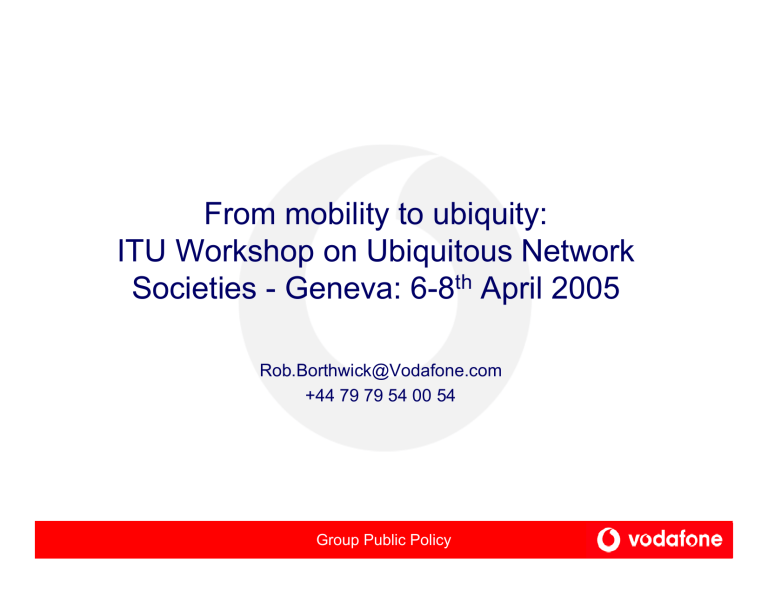
1
From mobility to ubiquity:
ITU Workshop on Ubiquitous Network
Societies - Geneva: 6-8
th
April 2005
Rob.Borthwick@Vodafone.com
+44 79 79 54 00 54
Group Public Policy
Agenda
Some starting points
Current network availability.
How is the mobile industry developing?
Turbulence ahead?
So what directions for public policy.
Rob.Borthwick@Vodafone.com
Group Public Policy
Some starting points
By Ubiquitous Networks we mean something beyond current fixed and 3G networks – but which – at the same time – will contain and be built on these technologies;
So a combination of new capabilities and existing (and some new) communications and IT infrastructure;
New capabilities particularly in the near environment – personal area networking and
RFID and in the far environment – global positioning;
Plus a degree of ability to select the underlying communications bearer being used according to location and type of customer demand;
Industry commentators hold out the prospect of substantial business productivity and consumer welfare gains;
But other stakeholders raise dystopian concerns – such as increased risk of the infringement of personal privacy;
So what might develop and how might the mobile industry approach it?
Rob.Borthwick@Vodafone.com
Group Public Policy
Current network availability
In a typical – developed country three spatial factors affect network availability:
Individual customer demand (large business, SME, residential customer);
local customer density (urban, suburban, rural); and
location in the core/periphery (for a settlement of the same size/density).
So a large business in a capital city may have a choice of: the fixed incumbent, 3-4 fixed competitive access providers, 3-4 mobile operators and various non-network competitors. Residential customers in a peripheral area may have the fixed incumbent and non-network competitors using it plus, possibly, a mobile operator.
For developing countries relative pattern of provision is similar, but lower overall revenue potential means that the choice is less, given equivalent circumstances.
Wider choice is emerging:
public wireless LAN providers;
new public wide-area mobile and nomadic providers;
private equipment able to select more effectively between providers.
But unanswered question is whether wider choice will extend outside core regions.
Rob.Borthwick@Vodafone.com
Group Public Policy
How is the mobile industry developing?
A period of significant change:
technological renewal by established players (2G to 3G);
new entrants attracted by apparent industry surpluses (spectrum auctions etc.);
industry boundaries blurring (content, payment mechanisms, broadcasting).
But some relevant trends also evident:
past “cooperative” perspectives on the role of competitors less relevant given international industry restructuring and under fire from regulators;
past definitions of economic activity based on technology not disappearing, but becoming less pronounced;
mobile operators seeking to offer “the best connection for the job” – this could be on
2G, 3G, W-LAN – or in locations not previously served.
So expect a wider choice of connection type within a single operator portfolio and from heterogeneous operator alliances and on the basis of resale between non-aligned operators.
But note that some promising technologies now seem more to be cul-de-sacs.
Rob.Borthwick@Vodafone.com
Group Public Policy
Turbulence ahead?
Some aspects of the ubiquitous network society look hard to monetize for certain players. Personal area networking seems likely to be equipment only rather than service and equipment based.
More seriously the communications and IT industry seems to throw up opportunities for the unscrupulous few to use new technology to limit the benefits for the rest of us.
Examples: spam on e-mail and on mobile; micro-frauds around subscription
SMS/SMS payment mechanisms; phishing and spy-ware.
So expect greater ubiquity to be accompanied by greater attempts to exploit anything that can be connected to for “free” or is otherwise insecure.
If concerns around 3 rd party knowledge of customers’ location (passive location services) or of what they are wearing / carrying (RFID) actually turns into risks of exploitation or harm then expect significant customer push-back.
Commercially stable solutions lie in product designs which inherently address these concerns. For example internal applications can “design out” concerns, the development of new security capabilities together with charges for access outside personally or commercially trusted groups offer customers control.
Rob.Borthwick@Vodafone.com
Group Public Policy
So what about policy?
Ubiquitous Network Societies start with access to any network, and will be built by encouraging a heterogeneous choice of networks.
For Vodafone the right kind of communications policy environment for UNS is one which encourages and sustains infrastructure investment. This will facilitate new technologies and the extension of geographical service availability.
Compare performance of 2G mobile with traditional Universal Service concerns:
1.
services for people who are too poor to buy;
2.
services for people who are too extensive to serve; and
3.
access for customers who cannot use mainstream terminals.
In developed countries pre-pay mobile with no periodic charge means that there is effectively no poverty-related digital divide in mobile. Competition has encouraged network roll-out in rural areas beyond policy makers’ expectations and delivered geographical price averaging. Market forces now coming to bear on issues around non-mainstream terminals as “ unserved ” segments are identified and targeted.
Expect to see similar outcomes for 3G mobile and for ubiquitous networks provided that market incentives are not disrupted.
Rob.Borthwick@Vodafone.com
Group Public Policy
